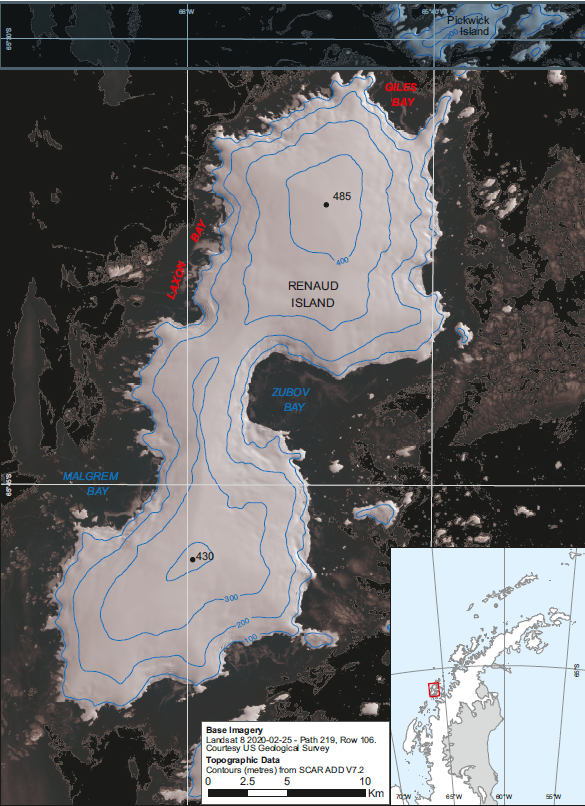The Government of the British Antarctic Territory has announced 28 new place names in the Territory today to commemorate the 200th Anniversary of the discovery of Antarctica.
All of the names on the list were chosen to honour people who have made an exceptional contribution to furthering the understanding, protection and management of Antarctica over the last fifty years, and whose achievements warrant highlighting alongside those of the early explorers.
Included in the list of honours were two scientists, Professor Seymour Laxon and Dr Katherine Giles, who were integral to the development of the Centre for Polar Observation and Modelling and whose research still underpins much of our work today. Sadly, Professor Laxon and Dr Giles both died within three months of each other in 2013.

Professor Seymour Laxon (1963-2013)
| Laxon Bay | Bay about 10 km wide and 3 km deep between Palosuo Islands and the west side of Renaud Island, Biscoe Islands. |
Named for Professor Seymour Laxon, Director, Centre for Polar Observation and Modelling at University College London.
Professor Laxon was at the heart of all the achievements and successes of the Centre for Polar Observation and Modelling for two decades. His scientific breakthrough was to distinguish the ice surface from the water surface in satellite radar altimeter measurements of ice-covered oceans. This led to the first detailed map of the Arctic gravity field, revealing new tectonic features beneath the seafloor, and water circulation beneath the ice. His work also provided evidence that led to the development of the European Space Agency’s CryoSat mission.
Professor Laxon was an empirical scientist, and the integrity with which he treated his data was matched by the integrity and generosity with which he treated his colleagues and students, many of whom are now furthering our understanding of the Arctic through their own careers in the UK and overseas.
More detail about Professor Laxon’s life and work can be found in his obituary in The Guardian (February 2013).
Dr Katherine Giles (1978-2013)
| Giles Bay | Bay about 4 km wide and 3 km deep between Weaver Point and Tula Point at the northern end of Renaud Island, Biscoe Islands. |
Named for Dr Katharine Giles, Lecturer at University College London, a ground-breaking researcher into sea ice, ocean circulation and wind patterns who worked at University College London.
Dr Giles’s research focussed on sea ice, ocean circulation and wind patterns, and pioneered the use of satellite altimetry to measure the thickness of Arctic and Antarctic sea ice. After it had become clear that sea ice freeboard could be determined from satellite altimetry, Dr Giles performed some of the first ground-based experiments to show how the same observations could be accurately related to sea ice thickness. This led her to undertake field campaigns to characterise radar penetration into sea ice, both in the Arctic and the Antarctic, and to identify that, in 2007, sea ice thinning accompanied the then record Arctic sea ice minimum extent.
Dr Giles was the first person to appreciate that altimeter observations between sea ice floes were more than just a stepping stone to measuring sea ice thickness: she demonstrated that they could also show how winds affected the newly-exposed Arctic Ocean.
She was also a passionate science communicator. The Dr Katharine Giles science blog prize is awarded by the Association of British Science Writers each year, founded following her tragically early death.
More detail can be found in Dr Giles’s obituary in the Times Higher Education (April 2013).

Renaud Island at the Antarctic Peninsula, 65.6924 South 65.9872 West
Also included in the list of honours is Professor Dame Jane Francis (Director of the British Antarctic Survey):
| Francis Peak | Locally prominent peak (1136 m), with imposing cliffs on its eastern side, on the horseshoe shaped ridge east of Mount Liotard, Adelaide Island. |
Professor Dame Jane Francis is the current and first female Director of the British Antarctic Survey (from 2013), and Chancellor at the University of Leeds (from 2018).
Dame Jane is a leading palaeobotanist and Professor of palaeoclimatology who specialises in the study of fossil plants, especially woods, and their use as tools for climate interpretation and information about past biodiversity in the polar regions. She is the first woman to chair a Working Group of Antarctic Treaty Consultative Meetings. She was awarded the Polar Medal in 2002 for outstanding contribution to British polar research and was appointed Dame Commander of the Order of St Michael and St George (DCMG) for services to polar science and diplomacy.
The full list of new place names can be found here.
More details about place naming and the Antarctic Place Names Committee can be found at: www.apc.antarctica.ac.uk
